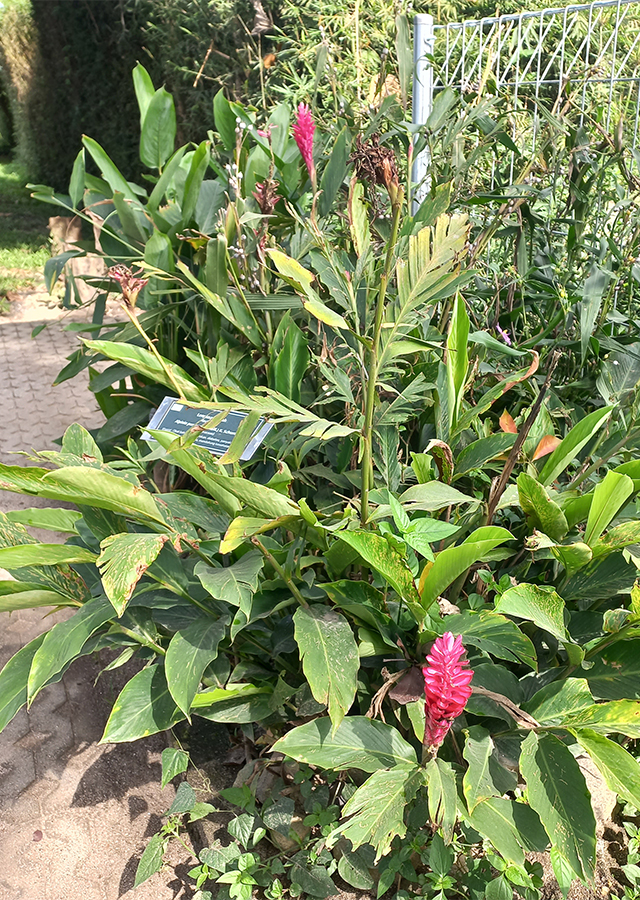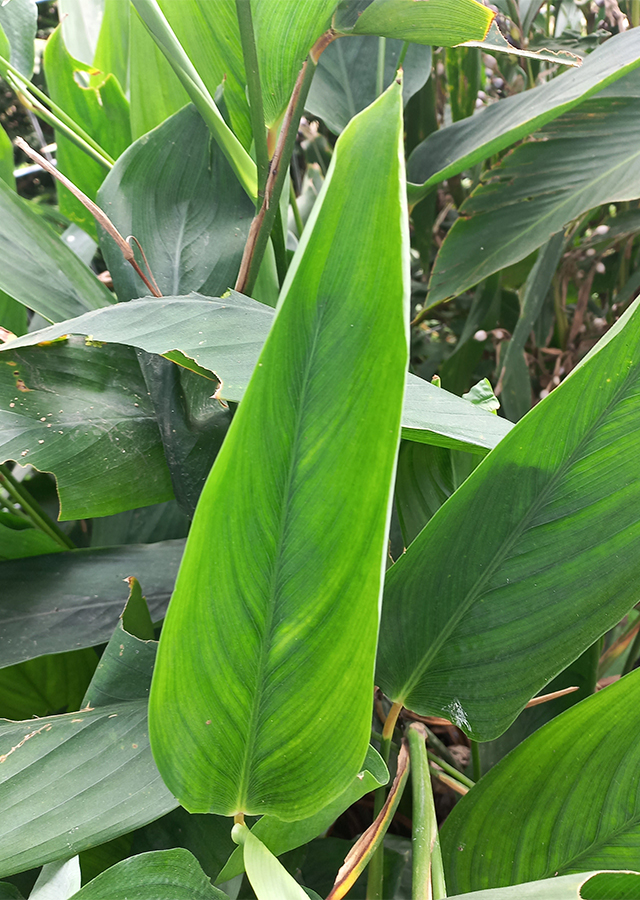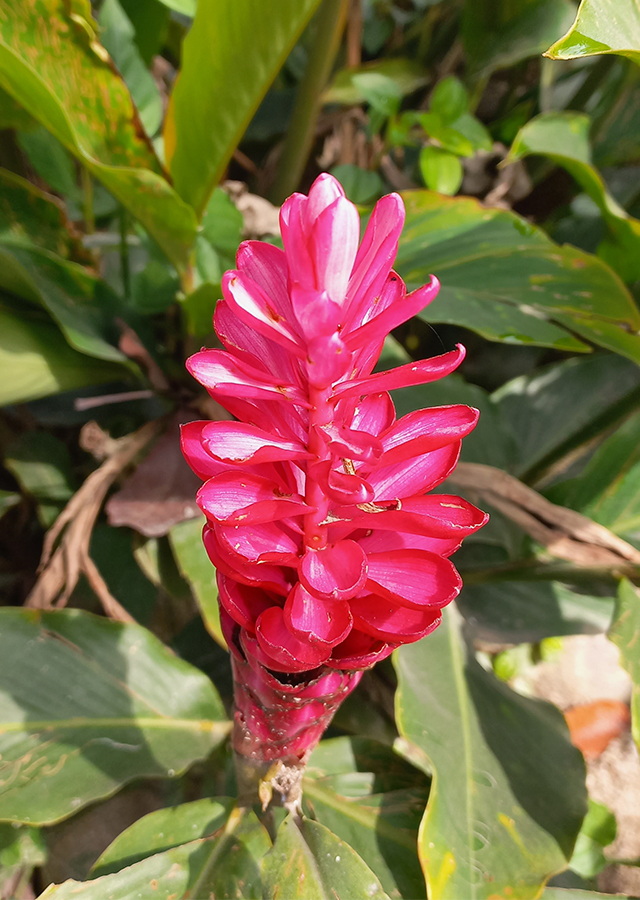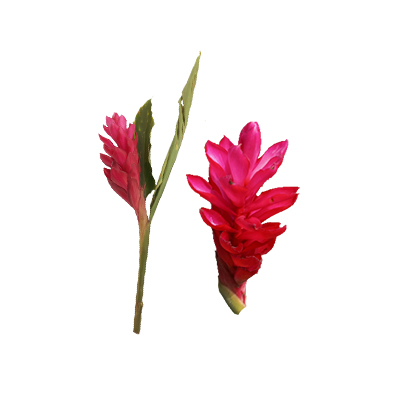Red Ginger
Alpinia purpurata (Vieill.) K.Schum
Zingiberaceae
Location in our garden
Principal



Synonym
Alpinia grandis K.Schum.
Guillainia purpurata Vieill.
Languas purpurata (Vieill.) Kaneh.
Habitus
Herbaceous. A herbaceous, perennial plants which producing a clump of leafy stems and grows upright up to 4 m tall.
Part Used
Leaves
Flowers
Fruit
Stem
Rhizome
Growing Requirements
Full Sunshine
Need Shade
Habitat
Wetland
Riverbanks
Forest
Terrestrial
Overview
Red ginger is native to eastern Indonesia to New Guinea, and the Southwestern Pacific (New Caledonia, Solomon Islands and Vanuatu). The plant is listed as invasive in Cuba and on several Pacific islands including Hawaii, Fiji, Micronesia, Guam, Palau, and Tonga. Widely cultivated in the tropics as an ornamental, the flower is often used in the cut flower industry. In adittion, the plant harvested from the wild for local use as a medicine. This plant is one type of spice that is widely used as a phytopharmaca product. The rhizome is contains volatile oil which is active as an antifungal and antibacterial.
Vernacular Names
Ginger rojo, Jenjibre cimarrón, Jenjibre rojo (Spanish), Alpinia (Cuba), Scharlachrote alpinie (Germany), Tevula (Tonga), Hong guo shan jiang (Chinese), Luyang pula (Philippine).
Agroecology
Under natural conditions, Alpinia purpurata can be found growing in moist secondary forests, moist roadsides, riverbanks, edges of mangrove swamps, wetlands, and it can persist in some areas such as urban forests, disturbed moist forest, old gardens. This plant can be found at elevations up to about 500 m. A. purpurata prefers to grow in moist areas with warm temperatures and high precipitation regimes. The mean annual rainfall in the range from 800-4.000 mm. It grows best in partially shaded areas, but it is also adapted to grow in open areas with full sunlight. Requires a moist and fertile soil.
Morphology
- Roots - aromatic rhizomes, grow and spread in thick clusters, produce aerial shoots when older shoots dried up. Rhizhome is slightly brown reddish with reddish scales, shiny and the inside of the rhizome is white.
- Stems - herbaceous, erect, slightly whitish green in colour. Pseudostems formed by leaf sheaths emerge from underground rhizomes.
- Leaves - alternate arrangement, long sheaths wrap around the stem, leaf blades oblong-shaped, measures 30 - 80 cm long and 10 - 20 cm wide, glabrous, apex short acuminate, sessile, sheaths pubescent at apex and along margins.
- Flowers - inflorescences terminal on leafy shoots, unbranched (occasionally branched in cultivated forms), basically cylindrical, 15-30 cm long, usually elongating considerably with age. Bracts overlapping, forming cone or funnel shape, bracts ovate to broadly obovate, bracts usually red (occasionally pink or white in cultivated forms), bracteoles reddish and tubular. Calyx reddish, glabrous, each lobe with a subapical spur. Corolla white, exserted just beyond primary bracts, llabellum white, with 2 distinct lateral lobes and a central segment that is distinctly 3-lobed or subentire, about as long as corolla lobes.
- Fruits - capsules nearly globose, 2-3 cm in diameter.
- Seed - approximately 3 mm long, angled, black, oily.
Cultivation
Propagated by seeds and rhizome division.
Chemical Constituents
Kumatakenin, stiosteryl-3-O-6-palmitoyl-ß-D-glucoside, β-sitosteryl galactoside, essential oil (α-pinene, β-pinene, β-caryophyllene, camphene, 7-epi-α-selinene, 1,8 cineol, kavikol acetate, methylcinnamate, galangin, eugenol, cis β-farnesen, 1-β-bisabolen, β-element), alkaloids, terpenoids, steroids, cardioglycosides, tannins, 4-morpholinomethyl-7-methoxycoumarin, methanesulfonate of (3R, 4S)-3-propargyloxy-4-[(R)-1-hydroxy-3-phenyl-3-butenyl]-1-(p-methoxyphenyl)-2-azetidinone, 5-butyl-3-methyl-1,2,3, 8a-tetrahydroindolizine, phenol, 4-(3, 7-dimethyl-3-ethenylokta-1,6-dienyl)-, methenolone, nonanamide, 5-hydroxy-5-methyl-2-(2-methylpropyl)- N-benzyl-, flavonoids kaempferol-3-O-glucuronide, rutin.
Traditional Medicinal Uses
- Salt and rhizomes are mashed together for treating headaches.
- A decoction of the leaves is used in the treatment of stomach complaints.
- The stems are used by Hawaiians for stomachaches.
- In Trujillo, Venezuela, oral use of boiled inflorescence used to treat cough symptoms.
- The fruit is used to treat sores.
- Studies suggest antioxidant, antimicrobial, antimycobacterial, antifungal, anticancer and vasodilating properties.
Part Used
Reference Sources
- Flora Fauna Web. 2021. Alpinia purpurata. https://www.nparks.gov.sg/florafaunaweb/flora/1/6/1645. 08-12-2021.
- Stuartxchange. 2017. Philippine Medicinal Plants: Luyang pula. http://www.stuartxchange.org/RedGinger. 08-12-2021.
- CAB International. 2021. Invasive Species Compendium: Alpinia purpurata (red ginger). https://www.cabi.org/isc/datasheet/4377#toPictures. 08-12-2021.
- Useful Tropical Plants Database. 2021. Alpinia purpurata. http://tropical.theferns.info/viewtropical.php?id=Alpinia%20purpurata. 08-12-2021.
- Sujono H. dkk. 2019. Antifungal activity of red galangal oil (Alpinia purpurata K. SCHUM) against Malassezia furfur. Jurnal Kartika Kimia, 2(2): 86-91.



